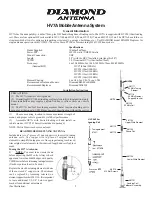
2
With quality VSWR meter, check VSWR on lower portion of 6m (50.150
MHz). Tune the copper rod by trimming from top in 1/8" increments only
until lowest VSWR is obtained. Shortening extension element will have
effect of raising the resonant frequency.
You may have to re-adjust the VSWR on 6m band when using additional
HVC loading coils. Do not re-install original 6m tuning element until trim-
ming of all HVC loading coils is finished. This will allow for any additional
adjustment that may be necessary.
(4)
When tuning optional loading coils (HVC7, HVC14, HVC18, HVC21
and HVC28 (enclosed in package), install on top (vertical position) and
proceed to tune the coils. Replace original tuning element with enclosed
copper wire. Install copper wire into HVC loading coil until it seats at the bottom.
NOTE: HVC loading coils have a limited tuning range – refer to “frequency”
under specifications for bandwidth.
Choose your desired center frequency and trim for best VSWR. Simply trim
the copper wire from the top in 1/8” increments until desired center
frequency is achieved.
(5)
Once you have adjusted all coils for best VSWR in the vertical position,
you may assemble one optional coil horizontally. It is best to use the lowest
frequency coil in the vertical position. All coils can work horizontally
except the HVC7 (40m); it must be in the vertical position due to its size. The
horizontal coil should point to the rear. The VSWR will change slightly by
adding a coil horizontal; therefore, it is best to check your VSWR readings
to verify adjustment.
To add loading coil in horizontal position, simply remove Philips head screw
from opposite side of #981116 (50 MHz Element support bracket) and screw
HVC coil into position. (See Illustration) All HVC loading coils have lock
nut on threaded end to aid in fastening coil into position.
NOTE: Do not dispose of Philips head screw, as you may need it for future use.
(6)
To replace HVC loading coils, simply unscrew from 50 MHz coil and
replace with another using 10mm wrench for base of 50 MHz coil, and 8mm
wrench for lock nut on HVC loading coils. (See Illustration) Be sure loading
coils are fastened securely so they don't loosen from vehicle and road
vibration.
(7)
After all tuning and adjustments have been made, you can remove
the trimmed copper wire from the 50 MHz support bracket and the HVC
loading coils and trim the original steel tuning elements to exact length of
copper wire. Re-install in proper position and re-check VSWR.
(8)
The HV7A has a fold-over hinge for situations where the antenna
height is a problem. (See Illustration) Simply unscrew the fold-over lock,
LIFT UP, and tilt over 90°. Care should be taken when folding over, not to
damage vehicle or any HVC loading coils. Do not drive with antenna in the
folded position.
Discharge Protection Cap
Trim element with cutting device
appropriate for cutting metal. (i.e.
Hacksaw, etc.)
Metric Hex Wrench M4
Adjustment element length vs. frequency change on each fre-
quency band.






















